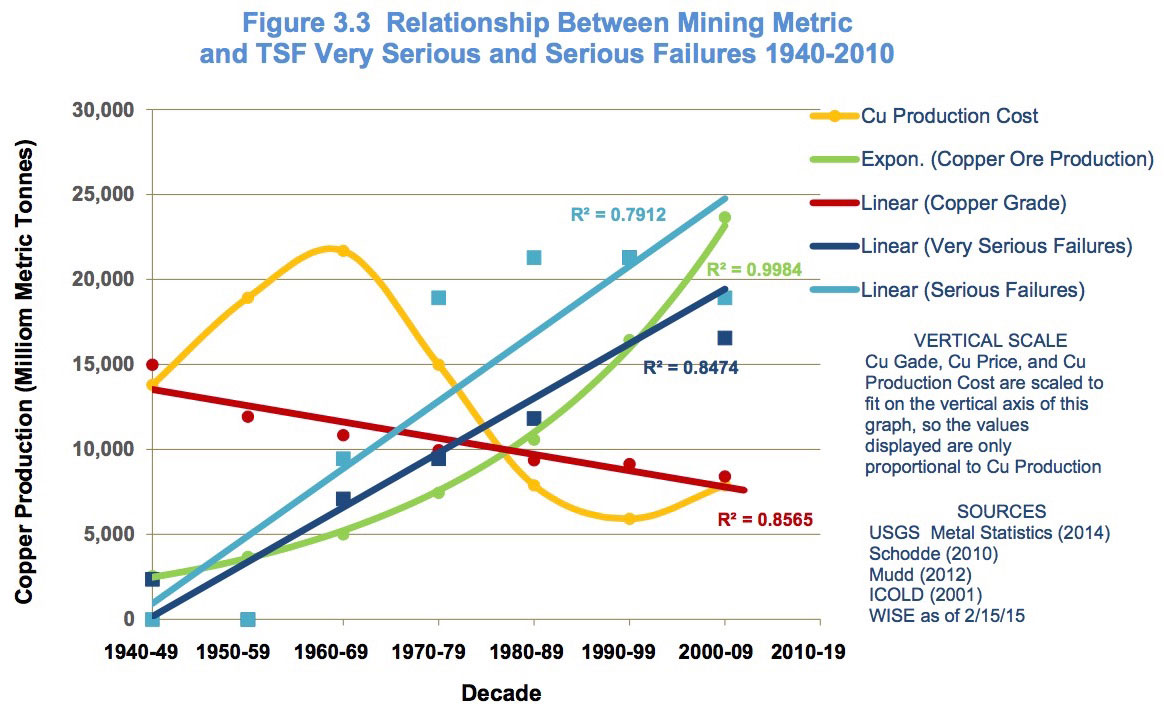A new study reveals that catastrophic mine waste failures are increasing in frequency, severity, and costs all around the world. The authors point toward poor regulations, poor practices, dicey mining economics, and ever larger mines as key factors behind those disasters.
This dangerous trend needs to stop.
The study by Bowker and Chambers, Risk, Public Liability & Economics of Tailings Storage Facility Failures, found that nearly half of all recorded ‘serious failures’ happened in modern times, between 1990 and 2010. It calculated an average cost of $US 543 million for the most serious spills, with some climbing well above $US 1.3 billion.
Since 1990, a dozen spills even resulted in loss of lives – over 380.
British Columbia had the largest mine waste spill disaster in Canada’s history last year. Imperial Metals’ Mount Polley dam breached over 24 billion litres of mine waste – equivalent to 10,000 Olympic swimming pools – into surrounding waters.
But what has changed since Mount Polley over a year ago? Not much. No new regulations, no new laws, no new financial obligations to cover damages. Only promises for which we are still awaiting concrete results.
Why is the mining industry incapable of learning from its biggest mishaps? Why other industries, like the global aviation industry after a plane crash, are able to turn around –sometimes in matters of days– and implement immediate changes to prevent similar disasters?
Would we tolerate embarking an airplane or an elevator knowing there is a good chance it will fail? Would we tolerate a major hydroelectric dam failing? No. So why should we tolerate mining tailings dams to fail?
As observed by the International Commission on Large Dams: “tailings facilities are probably the largest man-made structures on earth.” They also contain some of the most toxic metals and substances to human health.
For decades now, mining companies have been in a downward spiral, competing for mining more resources out of deposits that are of lower ore grades.
In this madman's race to the bottom, the size of mines and economies of scale become increasingly crucial. Mines are becoming bigger, generating larger volumes of waste, stacked into higher tailings facilities.
Mount Polley’s taillings dam, for example, was about 35 metres high before it breached –equivalent to a 10-story-high building. The controversial KSM and Red Chris mines recently approved in northern BC will have waste dams twice as high.
Last year’s Mount Polley disaster and this new study on mine waste failures call for major changes in the way the mining industry is regulated in B.C. and around the world. But they also point to the urgent need to change the mining industry’s complacent culture around environmental failures and disasters.
Comments like those we heard recently from both B.C.’s Mines Minister Bennett and industry leaders, that tailings “accidents will happen,” implying that not much can be done to prevent them, or to pay for their damages, are unacceptable.
This is precisely what the Independent Expert Panel that reviewed Mount Polley’s spill told us in its January 2015 report: “The Panel does not accept the concept of a tolerable failure rate for tailings dams. To do so, no matter how small, would institutionalize failure.”
Much like the ‘zero tolerance’ cultural shift that took place –and that was hard fought by mineworkers’ unions— around health and safety of mineworkers in Canada in the 1970s, we also need to see a major cultural shift toward a ‘zero tolerance’ to environmental mine disasters.
All stakeholders -- governments, workers, communities, industry, investors, and insurers, need to deploy the same kind of efforts they did to bring down the rate of costly -- and deadly -- work injuries in the mining industry.
Not many people realize that today’s rate of work-related injuries in the mining industry is one of the lowest of all sectors in Canada, well below the national average, and still going down.
Failing to prevent work injuries is not accepted anymore in the mining industry; too costly, too deadly; “zero harm” is the goal. Why should it be different for environmental hazards and disasters?
And just as much as much as mineworkers now have a right to say ‘no’ to dangerous work places, affected communities and the public should also have a right to say no to dangerous mines.
--
First published in Georgia Straight B.C., 7 August 2015, http://www.straight.com/news/504186/new-study-indicates-mine-waste-disasters-increasing-worldwide
See also:
- SIGN-ON: Canadian Provinces & Territories Must Act To Avoid Mine Waste Disasters
- Mount Polley mine disasters’ first anniversary is no reason to celebrate, July 31st 2015
- One Year In, Residents Remain Frustrated with Superficial Cleanup of Mount Polley Mine Spill
- A ‘Massive Deposit’ of Mining Waste from British Columbia’s Mount Polley Is Still Lingering
- Mount Polley A Year Later, Common Ground, Rod Marining, August 2015
- B.C. Mining Code Review Welcome, But Needs Broad Scope
- And more online everywhere: 'Mount Polley', 'Mine Waste', 'Disaster' ...
